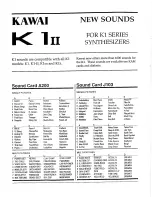
34
You should listen how the
XTOSC·Y
tone goes up and down in a stepped
pattern. The
S/H
is clocked by the
LFO·Y
and the
LFO·X
triangle wave is the
signal to be sampled. At each
LFO·Y
step the
S/H
takes the current voltage
of the
LFO·X
and sends it to the
XTOSC·Y
. Now change the
RATE
of the
LFO·Y
an see how each step is shorter or longer. Change also the
LFO·X
RATE. Turn the
GLIDE
CW and listen how each step is smoothed with a
slope.
Now switch the
XTOSC·X
to the LFO mode and disconnect
LFO·X
and
LFO·Y
from the patch. You should be listen
XTOSC·Y
being modulated by random
voltages. This is because the
NOISE
is normalled to the
S/H
SIG and the
XTOSC·X
square wave to the
S/H
CLOCK
. This generates random stepped
voltages. Change the clock rate and experiment with different values.
But the
S/H
can also work at audio rates. Switch the
XTOSC·X
to oscillator
mode and connect the
S/H
OUT
to the
VCF
IN 1
. Now turn up and down the
XTOSC·X
RATE
. You should listen a dithering effect in the noise, like a digital
sound. This is very close to a low resolution digitalization. The clock rate is
lower than the processed signal so we listen a lot of (great) artefacts.
Tips:
1. Experiment with different oscillator waves.
MIX
them through the
S/H
.
2. Connect a microphone to a preamp and connect it to
S/H
SIGNAL
. Use an
oscillator as a clock source and play it with the MIDI keyboard.
3. Process envelopes, LFOs and any kind of signal with the
S/H.
NOTES ON THE S/H
1. The
S/H
can work at CV and audio rates. At a very slow clock rates you
may feel how the CV falls down. This is a compromise in order to be able to
use it at audio rates.
2. The clock input will accept any kind of signal. It will ignore the negative
part of the signal an will take only the positive one. It will start to work over
3V.
3. If you use the
GLIDE
function at audio rates you will notice how it filters
the sound like in a LPF.
Содержание ANTS!
Страница 1: ...ANTS PLANKTON ELECTRONICS ...
Страница 2: ......





































